Slavery abolitionists celebrated
in
Ipswich street names
The bi-centenary of the
Abolition of Slavery Act
which became law on 25th March, 1807 gave us all a chance to reflect on
the spoils of Empire and the price paid by so many anonymous people who
were sold into slavery in the production of those vast riches. Two of
the important figures in the history of Ipswich are Dykes Alexander and
his son Richard Dykes Alexander, a noted photographer of the town. The
latter built his house on the corner of St Matthews Street and Portman
Road; long empty, this distinguished building was in 2009 extended and
refurbished as student flats. When Richard Dykes Alexander (see our plaques page) made land
available
for housing in the 1850s he stipulated that some of the street names
should be those of leading abolitionists. Four British names and
arguably four American names appear in the list.
Gibbons Street
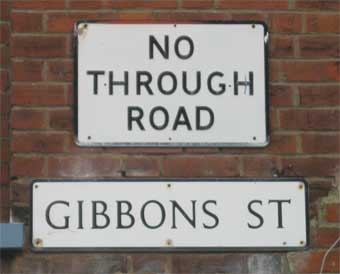 2014
images
2014
images
Abigail
Hopper
Gibbons (1801-1893): an American Quaker who aided runaway
slaves; she also nursed in the American Civil War and became a teacher.
Her father, Isaac Hopper, and her new husband, James Gibbons, were
disowned by the Society of Quakers for their anti-slavery
activities. See Elliott Street Bakery.
Emlen Street (and Burlington Road)
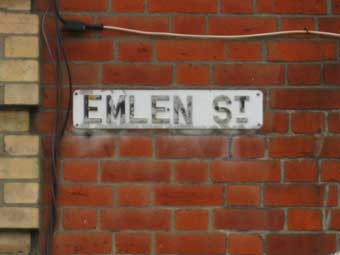
Samuel
Emlen
(1789-1828 1766-1837): a Quaker and doctor of
medicine [see update below]. He created a an American
institution for the education and maintenance of children of African
and Indian descent and he lived in Burlington, New Jersey, whence we
get the name Burlington Road.
[UPDATE
12.12.19: 'Hi Borin,
Thanks for doing your Historic Lettering web site -- very
interesting! I am distantly related to the Samuel Emlen*** you
mention on the abolitionists street names page. I never would
have known he had a street named after him in Ipswich if it wasn't for
your web site. I have a small correction for you. You give Samuel
Emlen's birth/death dates as 1789-1828 and say he was a doctor of
medicine. That's actually a different Samuel Emlen (there were a lot of
them). The Samuel Emlen you want was born in 1766 and died in
1837. He was not a doctor. And he was married to another
one of William Dillwyn's daughters, Susannah. You are correct
that he founded the institute for the education of children of African
and Indian descent, and that they lived in Burlington, New Jersey.
Thanks again for the great web site.
***I'm actually not a descendant of that Samuel Emlen, but rather the
Dr Samuel Emlen [1789-1828] that you originally had there. The two Samuel Emlens
were 2nd cousins, once removed. I have two letters written by
Susannah Dillwyn Emlen to Dr. Samuel Emlen, handed down to me through
the family. She was quite prolific with her correspondence --
several libraries in the Philadelphia area have collections of her
letters.
-Dave Emlen, Rochester, New York.' Many
thanks to Dave for this valuable correction and additions.]
Elliott Street
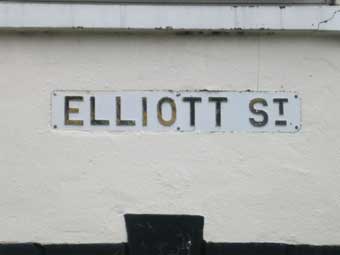
Edward
James Eliot
(1758-1797): an MP and friend of Wilberforce and Pitt, in whose
government he served. An active supporter of abolition. On wonders why
the 'l' and 't' in the name were doubled when it came to the
street-naming. See Elliott Street Bakery.
Could it be just an error... or is it that Elliott Street in Ipswich is
actually named after
somebody else?
[UPDATE 18.5.2019: 'I have seen
your page before, as I've been
interested in the Abolition movement for years! Going through some old
newspapers from Ipswich, it appears that most of those street names
came into being in the 1860s, as they all start appearing in notices at
the end of that decade.
While the name of Edward James Eliot was often misspelled, it seems
unlikely that it would have happened on a street sign. It's not
impossible, but I would think it rather unlikely.
It's interesting to note that some of EJ Eliot's great-grandchildren
ended up living in Ipswich! They each have web-pages: John
Eliot Pringle and Edith
Blanche Pringle.
The most remembered family home was 27 Graham Rd, Ipswich. It was
written about by the great-great
granddaughter of EJ Eliot:
-Sarah (Eliots of Port Eliot
website).'
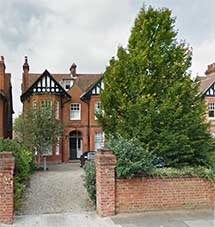 27 Graham
Road
27 Graham
Road
Wilberforce Street
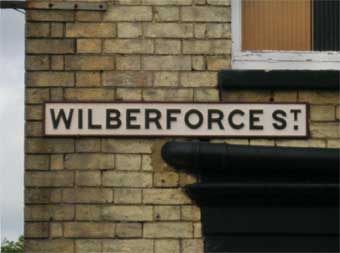
William
Wilberforce
(1759-1833): independent MP for Kingston-Upon-Hull (commonly called
Hull), friend of William
Pitt, The Younger. The main public face of the activisits, he is
buried in Westminster Abbey next to Pitt. See also Primitive Methodist Chapel.
Benezet Street
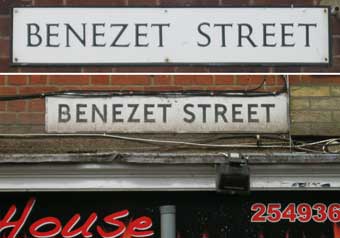
Anthony Benezet
(1713-1784): born in France, moved to Holland, London and finally
to
Philadelphia; he bacame a Quaker. His writing influenced Clarkson's
Cambridge essay opposing slavery. We have a comparison
of period and contemporary views of Benezet
Street.
Granville Street
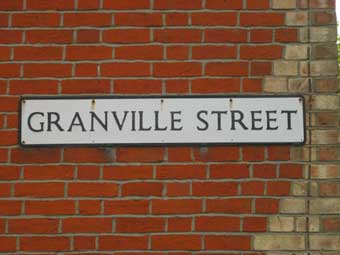
Granville
Sharp
(1735-1813) challenged slavery in law and was the first President of
the 1787 Abolition Committee. Interesting that the Borough chose the
first name of this gentleman for the street name, particularly as we
haven't been able to trace an already-existing 'Sharp Street'.
Dillwyn Street
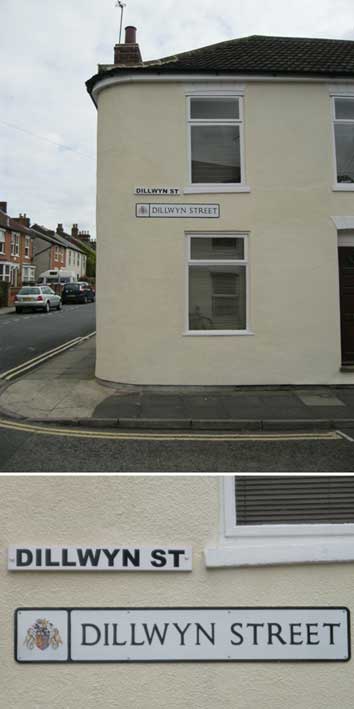
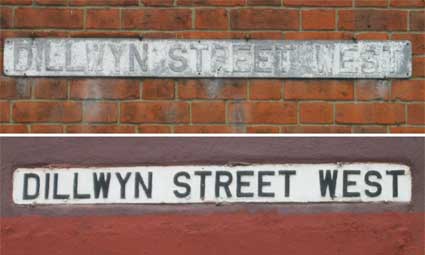
Above: Dillwyn Street: so good they
named it twice.
William
Dillwyn ([1743]-1824): a Quaker merchant born in
Philadephia, he
campaigned against slavery in England from 1774. His daughter, Ann,
married
Richard Dykes Alexander (see our Plaques
page). Samuel Emlen (see above) was married to Susannah, another of William
Dillwyn's daughters.
Clarkson Street
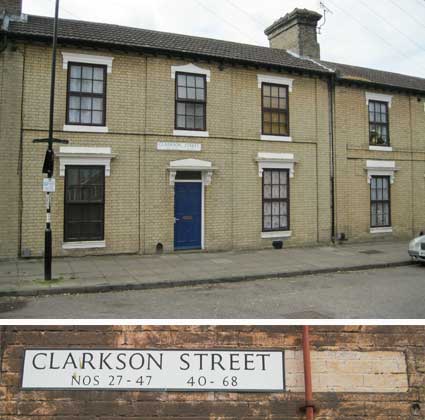
Thomas
Clarkson
(1760-1846) is the best known of the abolitionists, living for the last
thirty years of his life at the late 16th century Playford Hall.
William Wilberforce's right
hand man, he is said to have travelled 10,000 miles on horseback over
twenty years interviewing sailors, lecturing, collecting facts and
eyewitness accounts for the movement and for Wilberforce's speeches.
There is a memorial to Clarkson in Playford church. Home of St Matthews Hall lettering. See also Primitive Methodist Chapel.
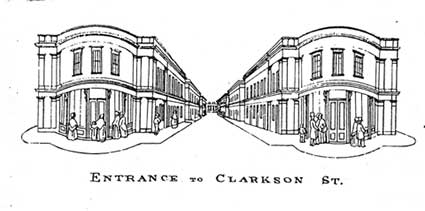 Image
courtesy James Bettley
Image
courtesy James Bettley
Above: an architect's visual of the 'town end' of Clarkson Street;
thanks to James Bettley (see Reading list).
As far as we can tell, this attractive street entance was never built
(or has been greatly alteres/demolished and replaced.
Burlington Road
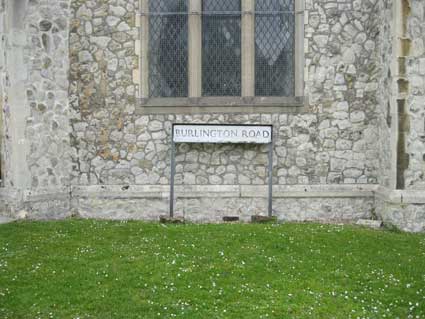
Burlington
Road
see Samuel Emlen (above). The sign unearthed from its moorings, leans
against the former Presbyterian church wall (The Oasis Centre) in
2014.
 1867
map
1867
map
Richard Dykes
Alexander's house is situated
at the top of Mill Street
(now the upper section of Portman Road) as it meets St Matthews Street.
The map detail (above) from White's map of
Ipswich 1867 shows the garden behind the house in which the
pioneering photographer was himself photographed with family members
(see below).
The large parcel of land which he owned enabled the residential streets
to be laid out celebrating the slavery abolitionists in their naming.
At this
date two curving roads come off the centre of Burlington Road and they
are 'Burlington Road North' (meeting Benezet
Street at London Road) and 'Burlington Road
South' (meeting Mill Street). Today they are Stevenson Road and Dalton
Road respectively – presumably named after Scottish
novelist, poet, essayist, and travel writer, Robert
Louis Stevenson (1850-1894) and author of
adventure stories for youth, William Dalton
(1821-1875). However, English
chemist, physicist, and meteorologist, John
Dalton FRS (1766-1844) is a possible inspiration for the latter. In
1867 Gibbons Street and Elliott Street had yet to be built.
'Handford Lodge', home of engineer Peter
Bruff, can be seen south of Handford Road, with Handford Mill (marked
here 'Old Mill') to the
east, near to the end of the wider part of the Little
Gipping river. At this date the course of the river down to join
the Orwell was at ground level (today run through a culvert below the
roads and pavements). The 1867 map labels all parts of the river
'Gipping'; today, this branch is known as the Alderman Canal (see our Water in Ipswich page for more information about
the Ipswich rivers).

We are indebted to the Ipswich Society Newsletter,
Issue 168, July 2007
for inspiring the beginnings of this page.
See also our Lettered castings
index page.
Related pages:
House
name plaque examples: Alston Road;
Bramford Road;
Broomhill Road; Burlington Road; Cauldwell Hall Road; Cavendish Street; Marlborough Road; Rosehill area;
Ipswich & Suffolk Freehold Land
Society (F.L.S.); California
Street index; Origins of street names
in Ipswich;
Dated buildings list; Dated buildings examples;
Named
buildings list;
Named (& sometimes dated) buildings
examples.
Street nameplate; Examples
of Street nameplates (Parliament Road
etc.);
Brickyards; Ropewalks
Home
Please email any comments and contributions by clicking here.
Search Ipswich
Historic Lettering
©2004 Copyright
throughout the Ipswich
Historic Lettering site: Borin Van Loon
No reproduction of text or images without express written permission






















